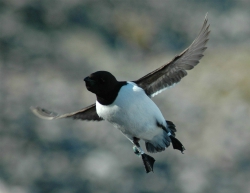Impact of shrinking sea ice on Arctic seabirds
Global warming could increase mercury (Hg) concentrations in Arctic marine food webs by releasing pollutants held within the sea ice, permafrost and glaciers. Other sources include the opening up of sea lanes and the development of industry within the Arctic, as well as the modification of pollutant chemistry due to changing conditions. The EU-funded project ARCTOX (Sea-ice shrinking and increasing human activities in the Arctic: What risks for the avian biodiversity?) was established to monitor the impact of pollutants on the region’s seabirds and develop an international network for studying contamination in seabirds and marine food webs at a very large, pan-Arctic scale. Researchers from the CNRS and the University of La Rochelle (France) investigated the long-term and seasonal variations of Hg in organisms and the extent to which migratory seabirds become contaminated during the wintertime, when they are outside the Arctic. Impacts of Hg on seabird reproduction and survival were also determined. Seabird populations at risk ‘Scientists showed that Hg, which is a powerful neural toxicant, could be a major stress factor in overwintering birds,’ explains Dr Jérôme Fort, the scientific coordinator of ARCTOX. ‘It may have played a role in the massive seabird mortality of February-March 2014 when 43 000 seabirds originating from the sub-Arctic and northern Europe were found dead along the French Atlantic coasts. Beached emaciated birds showed Hg concentrations above levels associated with sub-lethal effects on kidneys, suggesting Hg toxic effects.’ Hg can also act as an endocrine disruptor, affecting the ability of seabirds to reproduce. By focusing on a breeding population of little auks (Alle alle) in East Greenland, ARCTOX found that exposure of females to Hg prior to the breeding season was related to smaller eggs and reduced body mass in hatchling chicks. This could have a possible long-term negative impact, causing a decline in population numbers. An international sampling network has therefore been established to conduct large-scale studies and provide a fuller understanding of the origin and impact of Hg contamination in the Arctic. This has allowed scientists to map Hg concentration across Arctic marine ecosystems and identify hotspots of Hg contamination that might require specific attention and protection. ‘This network can be used to study other pollutants of concern in the future and monitor long-term changes in the contamination of Arctic seabirds and marine food webs at the Arctic scale. Such an approach will give decision-makers a more complete picture of what happens to Hg in the Arctic and the associated toxic risk,’ says Dr Jérôme Fort. Long-term impact on the Arctic By providing new insights into long-term trends of Hg in some Arctic marine systems, ARCTOX showed that Hg concentrations continue to increase in some Arctic regions and that mitigation strategies need to be discussed in order to understand these trends and how they may be reversed. Furthermore, project research provides new knowledge about the risks faced by Arctic seabirds, revealing that they are exposed to environmental pollution throughout the year both inside and outside the Arctic. This highlights the importance of concerted international actions to successfully tackle the threat posed by environmental pollution to Arctic wildlife. Professor Paco Bustamante, the project coordinator of ARCTOX, reflects on the possible environmental effects of a decline in seabird populations: ‘They play a key role in Arctic marine food webs, especially in the transfer of organic matter and nutrients in their ecosystems.’ He adds, ‘Moreover, seabirds have a large, circumpolar distribution in the Arctic. A decline in seabird populations could therefore affect the structure, dynamics and functioning of the entire marine food web.’
Keywords
Sea ice, Arctic, seabirds, biodiversity, marine ecosystems, mercury, ARCTOX







